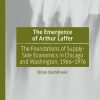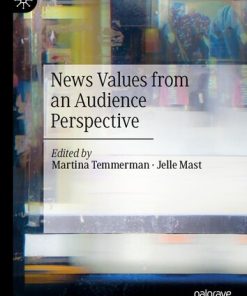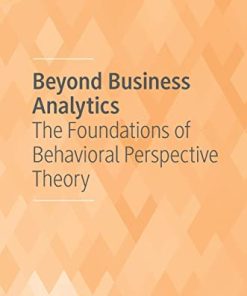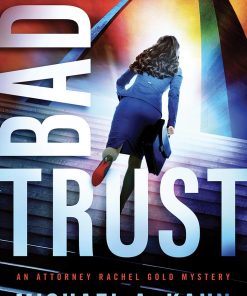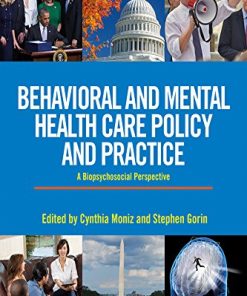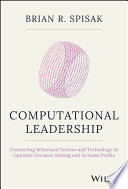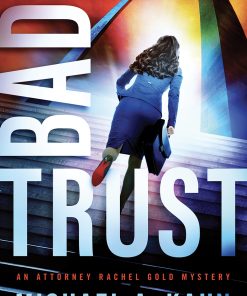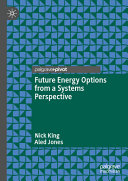Escaping from Bad Decisions A Behavioral Decision Theoretic Perspective 1st edition by Kazuhisa Takemura 0128160336 9780128160336
$50.00 Original price was: $50.00.$25.00Current price is: $25.00.
Escaping from Bad Decisions A Behavioral Decision-Theoretic Perspective 1st edition by Kazuhisa Takemura – Ebook PDF Instant Download/DeliveryISBN: 0128160336, 9780128160336
Full download Escaping from Bad Decisions A Behavioral Decision-Theoretic Perspective 1st edition after payment.

Product details:
ISBN-10 : 0128160336
ISBN-13 : 9780128160336
Author : Kazuhisa Takemura
Escaping from Bad Decisions presents a modern conceptual and mathematical framework of the decision-making process. By interpreting ordinal utility theory as normative analysis examined in view of rationality, it shows how decision-making under certainty, risk, and uncertainty can be better understood. It provides a critical examination of psychological models in multi-attribute decision-making, and evaluates the constitutive elements of “good” and “bad” decisions. Multi-attribute decision-making is analysed descriptively, based on the psychological model of decision-making and computer simulations of decision strategies. Finally, prescriptive examinations of multi-attribute decision-making are performed, supporting the argument that decision-making from a pluralistic perspective creates results that can help “escape” from bad decisions.
Escaping from Bad Decisions A Behavioral Decision-Theoretic Perspective 1st Table of contents:
1. Introduction: Escaping from bad decisions
Abstract
1.1 The classical problem of bad decision-making and akrasia
1.2 Second-order desires and bad decisions
1.3 The perspective proposed in this book: avoiding bad decision-making through prescriptive heuristics based on scientific findings
1.4 An overview of the contents of this book and suggestion to avoid bad decisions
1.5 Conclusion and future perspectives
References
2. Formal definitions of the worst decisions, best decisions, and bad decisions
Abstract
2.1 Framework to describe decision-making
2.2 Worst option, best option, and bad decision
2.3 Conditions for guaranteeing preference relations of the worst and best options
2.4 Necessary and sufficient conditions for the existence of worst and best options
2.5 Conclusion
References
3. Rational choice, irrational choice, and bad decisions
Abstract
3.1 Economic man and rational decision-making
3.2 Greatest element rationalizability
3.3 Maximal-element rationalizability
3.4 Conclusion
References
4. Preference ordering and measurement
Abstract
4.1 Understanding preference relationships through ordering decisions and behavioral observations
4.2 Aspects of ordering decisions
4.3 What is the measurement of preference relations?
4.4 Quantitative representation of possible psychophysical laws and preference relations in terms of scale levels
4.5 Conclusion
References
5. Rational preference, irrational preference, and revealed preference
Abstract
5.1 Rationality criteria and revealed preference
5.2 The concept of revealed preference
5.3 Utility functions and indifference curves
5.4 Revealed preference
5.5 Irrational choice and revealed preference
5.6 Revealed attention
5.7 Empirical testing of acyclic preference relations
5.8 Conclusion
References
6. Multiattribute decision-making, multiobjective optimization, and the additive conjoint system
Abstract
6.1 Plurality of values and multiattribute decision-making
6.2 Difficulties of multiattribute decision-making
6.3 Theoretical examination when multiattribute decision-making does not satisfy weak order property of preference
6.4 Multiattribute decision-making and multioptimization
6.5 Additive conjoint structure and quasi best decision
6.6 Conclusion
References
7. A computer simulation of cognitive effort and the accuracy of two-stage decision strategies in a multiattribute decision-making process
Abstract
7.1 Introduction
7.2 Findings and problems of previous research on decision strategies
7.3 Purpose and methods of computer simulation 1
7.4 Results and discussion of computer simulation 1
7.5 Purpose and method of computer simulation 2
7.6 Results and discussion of computer simulation 2
7.7 General discussion
7.8 Conclusions and problems of this study
References
8. A computer simulation of bad decisions and good decisions: an extended analysis of two-stage decision strategies
Abstract
8.1 A comparison between additive strategy (WAD) and lexicographic strategy (LEX) in multiattribute decision-making
8.2 Methodology of this study
8.3 Results and discussion of computer simulation
8.4 General discussions
8.5 Conclusion
References
9. A process tracing study of decision strategies and bad decisions
Abstract
9.1 Implementation of the additive decision strategy and bad decision: a pilot study
9.2 How to examine the effect of a second-stage decision-making strategy using process tracking on the bad decisions
9.3 Results and discussion of the experiment
9.4 Conclusion
References
10. A process tracing study of bad decisions: using eye tracking in food decision-making
Abstract
10.1 The problem of risky food decision-making and the assumptions of this study
10.2 Method of the eye-tracking experiment
10.3 Results and discussion
10.4 Questionnaire survey
10.5 Conclusion
References
11. Decision strategies and bad group decision-making: a group meeting experiment
Abstract
11.1 Group decision and groupthink
11.2 Method of the experiment
11.3 Results and discussion
11.4 Conclusion
References
12. An observational experiment in group decision-making: Can people detect bad group decisions?
Abstract
12.1 Cognitive processes and groupthink in group decision-making
12.2 Pilot Study 1
12.3 Pilot Study 2
12.4 Method of the experiment
12.5 Result of experiment
12.6 Discussion
12.7 Conclusion
References
13. Revisiting the group decision-making experiment
Abstract
13.1 Irrationality and bad decision-making in group decision-making
13.2 Preliminary survey
13.3 Method for group decision-making experiment
13.4 Results
13.5 Discussion
13.6 Conclusion and future prospects
References
14. The detection of bad decisions and a voting experiment
Abstract
14.1 Detection of bad group decision-making and groupthink
14.2 Method of Experiment 1
14.3 Results and discussion of Experiment 1
14.4 Method of Experiment 2
14.5 Results and discussion of Experiment 2
14.6 Conclusion and future prospects
References
15. Situation dependence of group and individual decision making and bad decisions
Abstract
15.1 Decision-making strategies for individual decision-making and group decision-making by majority rule
15.2 Consequences from Condorcet’s Jury Theorem
15.3 Group decision-making in the situations where independence among group members is not ensured
15.4 Experimenton situation dependence of decision-making and bad decisions
15.5 Conclusion
References
16. The contingent focus model and bad decisions
Abstract
16.1 Situation dependence of decision-making and bad decisions
16.2 Framing effect as situation-dependent preference reversal
16.3 Inadequacy of utility theory for explaining the framing effect
16.4 Prospect theory explains the framing effect and its problem
16.5 Concept of the contingent focus model
16.6 Formulation of contingent focus model
16.7 Representation theorem of contingent focus model
16.8 Conclusion and future perspective
References
17. An experiment on, and psyschometric analysis of, the contingent focus model
Abstract
17.1 Risk attitudes and the contingent focus model
17.2 Experiment of contingent focus model and measurement
17.3 Experiment of contingent focus model
17.4 Conclusion and future perspectives
References
18. The contingent focus model and its relation to other theories
Abstract
18.1 Expected utility theory
18.2 A counterexample to expected utility theory: Allais paradox
18.3 Nonadditive probability and nonlinear utility theory
18.4 Why nonlinear utility theory cannot explain the framing effect
18.5 Framing effects and prospect theory
18.6 Relationship between the contingent focus model and nonlinear expected utility theory and prospect theory
18.7 Conclusion and future perspectives
References
19. The mental ruler model: Qualitative and mathematical representations of contingent judgment
Abstract
19.1 Contingent judgment
19.2 Contingent judgment and the problems in its modeling
19.3 Qualitative description of “mental ruler”
19.4 Mental ruler explanation using set theory and its mathematical description
19.5 Explanation of experimental findings
19.6 Conclusion and future perspectives
References
20. How attention arises in and influences decision-making
Abstract
20.1 Function of attention
20.2 Psychological model of attention
20.3 Mathematical model of attention rate to social events
20.4 Propositions and considerations derived from the model
20.5 Application to the psychometric model for attention rate to Covid-19 problem
20.6 Control of attention by psychological experiment
20.7 Model of category focusing and construction of mental ruler
20.8 Conclusion and future perspective
References
21. Escaping from bad decisions and future perspective
Abstract
21.1 Epistemology of bad decision
21.2 Individual decision and group decision strategies
21.3 Situational dependence of individual decision-making and its psychological laws
21.4 Nudges, boosts, and metacognition
21.5 Metacognitive model of decision-making process
21.6 Conclusion
People also search for Escaping from Bad Decisions A Behavioral Decision-Theoretic Perspective 1st:
escape behaviors a person from a situation
bad decision-making disorder
consequences of bad decision making
consequences of bad decisions
dealing with bad decisions
Tags: Escaping, Bad Decisions, Behavioral Decision, Theoretic Perspective, Kazuhisa Takemura
You may also like…
Uncategorized
Business & Economics - Responsibility and Business Ethics
Uncategorized
Uncategorized
Engineering - Social & Cultural Aspects of Technology
Fiction - Humour
A Relevance-Theoretic Approach to Decision-Making in Subtitling 1st Edition Łukasz Bogucki
Uncategorized
Engineering - Energy & Power Resources



